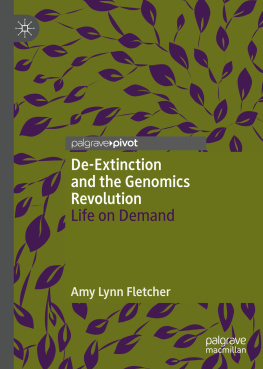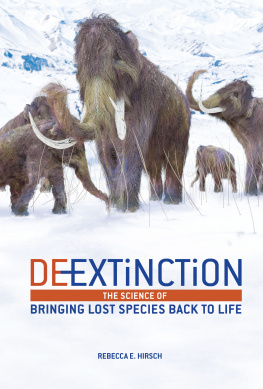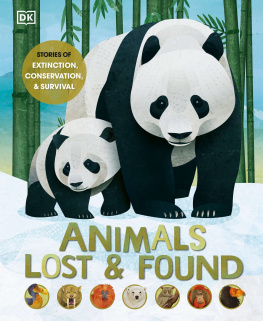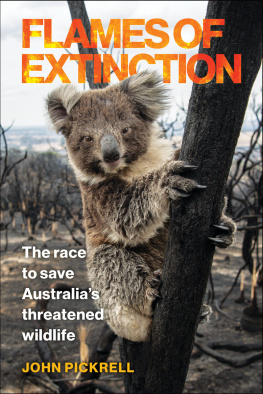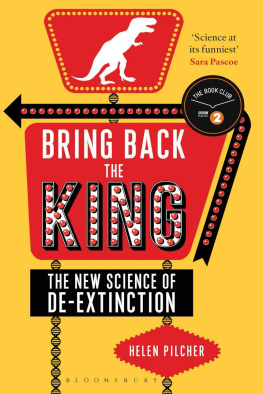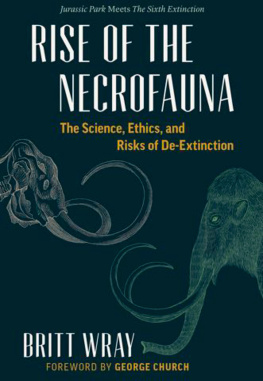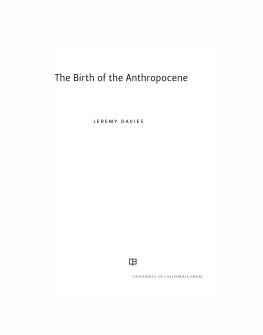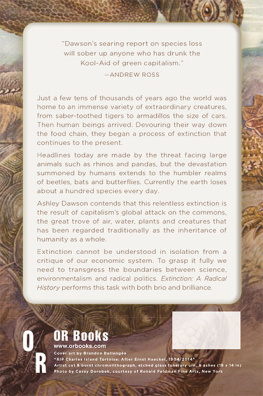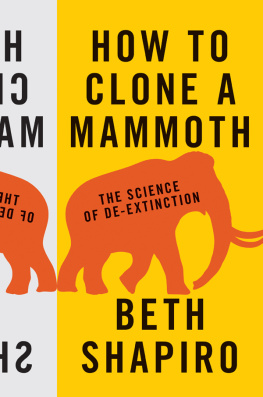Contents
Landmarks
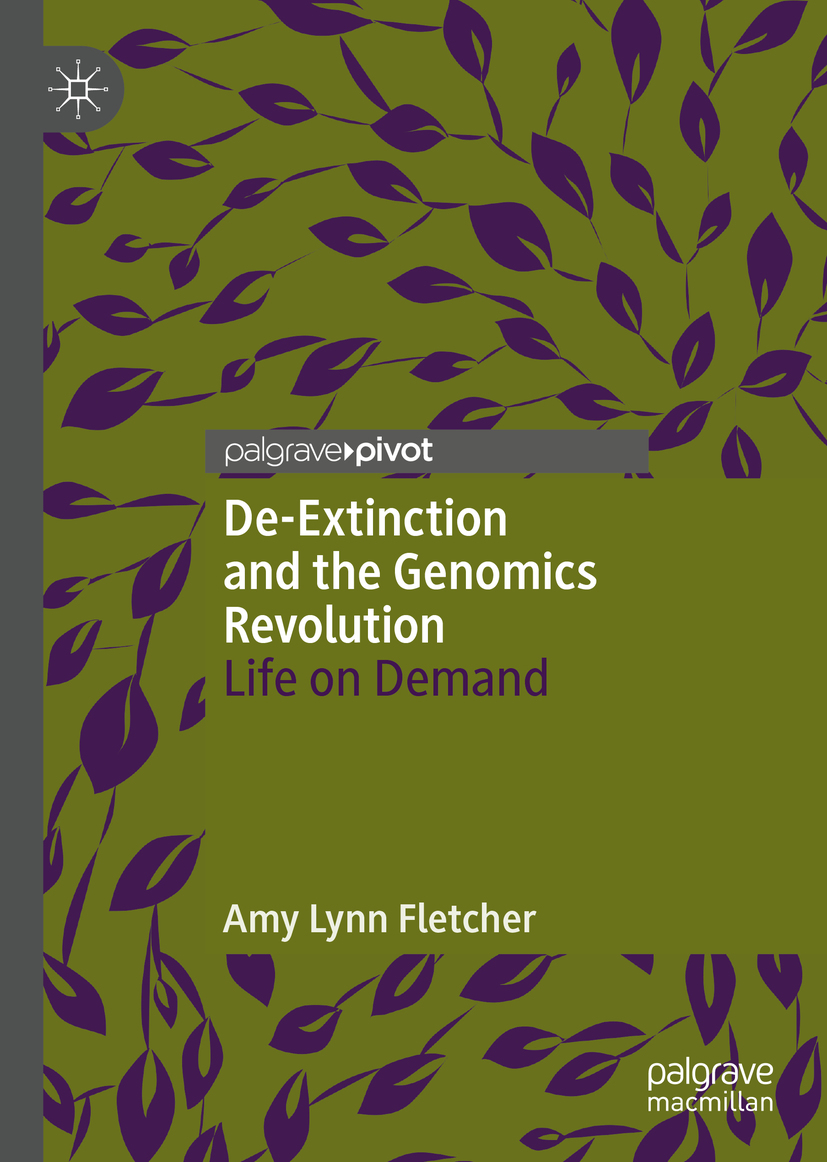
Amy Lynn Fletcher
De-Extinction and the Genomics Revolution
Life on Demand
Amy Lynn Fletcher
Christchurch, New Zealand
ISBN 978-3-030-25788-0 e-ISBN 978-3-030-25789-7
https://doi.org/10.1007/978-3-030-25789-7
The Editor(s) (if applicable) and The Author(s) 2020
This work is subject to copyright. All rights are solely and exclusively licensed by the Publisher, whether the whole or part of the material is concerned, specifically the rights of translation, reprinting, reuse of illustrations, recitation, broadcasting, reproduction on microfilms or in any other physical way, and transmission or information storage and retrieval, electronic adaptation, computer software, or by similar or dissimilar methodology now known or hereafter developed.
The use of general descriptive names, registered names, trademarks, service marks, etc. in this publication does not imply, even in the absence of a specific statement, that such names are exempt from the relevant protective laws and regulations and therefore free for general use.
The publisher, the authors and the editors are safe to assume that the advice and information in this book are believed to be true and accurate at the date of publication. Neither the publisher nor the authors or the editors give a warranty, express or implied, with respect to the material contained herein or for any errors or omissions that may have been made. The publisher remains neutral with regard to jurisdictional claims in published maps and institutional affiliations.
Cover illustration: Pattern Melisa Hasan
This Palgrave Pivot imprint is published by the registered company Springer Nature Switzerland AG.
The registered company address is: Gewerbestrasse 11, 6330 Cham, Switzerland
This book is dedicated to my dad, William Miller Fletcher, Jr. (19382018). Every word in this that is mine also belongs to you.
Contents
List of Images
The Author(s) 2020
A. L. Fletcher De-Extinction and the Genomics Revolution https://doi.org/10.1007/978-3-030-25789-7_1
1. Preface and Acknowledgments
Amy Lynn Fletcher
(1)
Christchurch, New Zealand
Abstract
This short book considers the implications of life-on-demand, that is, our ability to manipulate life via biotechnology. The enquiry centers on the idea of de-extinction, which gained global visibility in 2013 due to a TEDx De-Extinction event sponsored by several deep-pocketed stakeholders, but has its genesis in the scientific and social fascination with life, death, and immortality that dates to the nineteenth century and has persisted in various guises ever since. Against the backdrop of the contemporary extinction crisis, leveraging the power of biotechnology is arguably crucial to sustainability and even to human survival. Yet the dream of herds of mammoths trundling across the tundra or flocks of passenger pigeons darkening the skies again pulls on the imagination in ways that go far beyond science. This book thus scrutinizes the porous boundaries between the possible and the probable, fact and fantasy, inevitability and hype, that constitute science in society in the twenty-first century.
Keywords
Biotechnology De-extinction Immortality Silicon Valley Science in society Socio-technical Imaginaries
This book considers the implications of nature made to order or what I call life-on-demand. As digital and biotechnologies extend the frontiers of what is possible with respect to human manipulation of the natural environment and species, including our own, it is important to pause and consider both how we reached this moment and what it signifies about how human beings relate to both the contemporary extinction crisis and the environmental imaginary of nature yet to come. The enquiry centers on the idea of de-extinction, which gained global visibility in 2013 due to a major TEDx De-Extinction event sponsored by several deep-pocketed stakeholders, but has its genesis in the scientific and social fascination with life, death, and immortality that gripped the nineteenth century in Europe and the United States and which has persisted in various forms ever since.
De-extinction , and its more established conceptual cousin, genetic rescue , are two ideas that deserve to be taken seriously as innovative responses to the catastrophic extinction crisis that surrounds us. Genetic rescue seeks to maximize genetic diversity and minimize inbreeding through either natural or facilitated reproduction in small and isolated populations. Genetic rescue is a tool that can stem biodiversity loss more than has been appreciated, provides population resilience, and will become increasingly useful if integrated with molecular advances in population genomics. In the decades since, the extinction crisis has only worsened and is now reaching potentially catastrophic tipping points. Leveraging the power of genetic rescue and population genomics is crucial to averting this ecological disaster.
Yet as genetic rescue integrates within mainstream conservation work, a complementary idea, de-extinction, generates a steady stream of controversy, mass media attention, and public fascination since, at the farthest end of their scientific and entrepreneurial ambition, de-extinction proponents raise the possibility that advanced biotechnological tools such as reproductive cloning, gene editing, and ancient DNA analysis provide a means not only to revitalize extant populations but to bring back extinct species such as the woolly mammoth, Tasmanian tiger , or passenger pigeon. Critics of de-extinction worry about the diversion of scarce resources to such speculative resurrection projects and argue that the preservation of endangered species should be prioritized over fanciful projects to bring back charismatic lost species that departed the Earth quite some time ago. Proponents counter that de-extinction will actually contribute to deep ecological enrichment of the planet by restoring keystone species that humans carelessly decimated in earlier eras and that the long-term research will yield insights that may also save critically endangered species from passing over the threshold into extinction. As the field of de-extinction takes shape, other issues that have been well canvassed over the last decade include moral hazard, wherein the notion that species can be readily brought back reduces the incentive to protect them in the first place, the question of species authenticity, given that any resurrected species would technically be a hybrid (due to the use of surrogate species as either a genome template or for gestation), and the bioethical implications of bringing back a few remnants of species (such as woolly mammoths) that in their own time traveled in large herds and had fine-tuned social behaviors.
This book shifts focus from the arguments for and against de-extinction to consider its broader promissory and cultural dimensions. First, as will be seen, the idea of de-extinction is not quite as new as some of its contemporary proponents profess it to be, having a pedigree that tracks back to the emergence of the science fiction novel in the nineteenth century and to several influential scientific figures in the history of modern biology. Intimations of creating life-on-demand can be found in the nineteenth-century musings of physicist Ernst Mach (18381916) and biologist Jacques Loeb (18591924), for example, and, in 1951, the German scientist Heinz Heck (18941982) published accounts of his attempts to breed back the aurochthe progenitor of most contemporary cattle that, as a distinct species, had died out by 1667. This book places the contemporary subject of de-extinction and the media discourse scaffolding it into this broader historical context. It demonstrates how the twenty-first-century environmental imaginary, in which life is made to order through mastery of technology and seemingly fixed borders such as the line between extant and extinct become much more porous and open to human intervention, is firmly rooted in aspirations to exert control over nature that characterize the modern biotechnological project.

